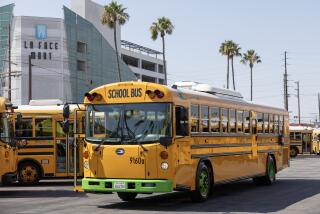Segerstrom Center facing more financial hurdles
- Share via
Carrying debt during turbulent economic times continues to cloud the financial picture for the Segerstrom Center for the Arts in Costa Mesa, which on Tuesday saw Standard & Poor’s Financial Services downgrade the investment outlook on its $232.5 million in construction bonds from “stable” to “negative.”
S&P analysts concluded that while “some aspects of the center’s operations have improved over the last year,” it hasn’t been enough to offset slow progress on a fundraising campaign that remains about $52 million short of its $240-million goal. The bonds were issued to ensure completion of the Renée and Henry Segerstrom Concert Hall, which opened in 2006. The debt is separate from a $1-million recession-fueled deficit the center said this week it had eliminated.
While the analysts report that the center believes the campaign has been “reinvigorated” by $4 million in recent pledges, they remained concerned about fundraising prospects of a campaign now in its 12th year. Furthermore, S&P sees “significant risk” from the looming July 2 expiration of bank guarantees, known as letters of credit, that are intended to reassure investors so they won’t demand higher interest on the variable-rate bonds. The banks promise to pay the bondholders should the center default.
The center plans to renew two of its three letters of credit, its spokesman, Todd Bentjen said Tuesday. But if the banks should balk, the center could face either higher payments to secure the letters or higher interest rates that would kick in if they expire.
The center’s annual interest payments on its bonds averaged $4 million the past two years. Standard & Poor’s predicted that those payments could skyrocket to $9 million a year in 2016 if the fundraising campaign doesn’t reignite.
Recently, the center has had to pay higher interest rates on some of its bonds because its third letter of credit went south — an Irish bank that stood behind $60 million worth of bonds is no longer creditworthy itself, due to a burst mortgage bubble in Ireland. In 2007-08, the bursting of the U.S. mortgage bubble cost the center dearly in a similar scenario — the insurance company that had stood behind its bonds took a bath, its guarantee became worthless and interest rates on the center’s bonds soared as high as 7.5% as it saw annual costs balloon from $5.9 million to $8.8 million.
Now it’s exposed again, and it aims to refinance bonds to keep payments under control. The answer: a new bond issue of up to $63.5 million that would replace some of the existing variable-rate bonds with less risky fixed-rate ones.
Standard & Poor’s gave an “A” rating to the new bond issue — the third-highest rating, signifying that the center should be strong enough financially to avoid defaulting on the bonds even in an economic downturn that would result in a 60% drop in the stock market and a 15% unemployment rate. But Standard & Poor’s said there could be trouble in 2016 when the new bonds mature if the center’s fundraising doldrums continue. At that point, the center would have to pay off the $63.5 million or do another refinancing.
Had the center raised the $240 million as planned it would have avoided all these complications. Investment earnings would be covering most or all of the interest payments through 2034, when the bonds mature. The cash would then be used to pay off the principal.
The board of the California Infrastructure and Economic Development Bank voted March 1 to OK the new fixed-rate bonds. A report from the development bank projects that the center stands to save $180,000 to $720,000 annually by refinancing. Paying off the bonds is the center’s responsibility; the state isn’t liable.
Bentjen said the center forecasts average interest rates on its bonds will rise only slightly because of the planned refinancing, from 1.76% to no more than 2%.
The center’s 2009-10 financial statement shows that it spent $7.5 million during the year to retire some of its bonds, reducing the amount on which it must pay ongoing interest from $240 million to $232.5 million.
Overall, the financial statement shows, the center had a $962,000 surplus for the year, abetted by $10.4 million in investment earnings following two years of losses.
More to Read
The biggest entertainment stories
Get our big stories about Hollywood, film, television, music, arts, culture and more right in your inbox as soon as they publish.
You may occasionally receive promotional content from the Los Angeles Times.











